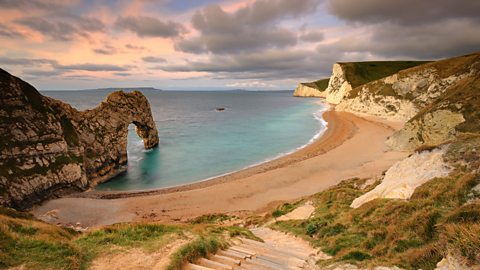Landforms created by erosion
The coastline is constantly eroding. There are four key types of erosion:
- Abrasion - waves transport material which hit the cliff and gradually wear it away.
- Hydraulic action - as waves approach the coast they trap air and force it into gaps in the cliff. Eventually this weakens the rock.
- Attrition - waves cause the rocks to crash against each other, breaking them down into smaller and rounder pieces.
- Corrosion (also known as solution) - salts and acids in seawater dissolve the rock gradually over thousands of years.
In addition, changes in landforms can be a result of wind erosion, weathering and sub aerial processProcesses located at the Earth's surface. such as mass movementA large-scale downward movement of rocks and material. .
Headlands and bays

headlandA high area of land that extends out into the sea. are usually formed of more resistantAble to withstand change, eg resistant rocks are hard and are not easily eroded. rock types than bayA low-lying inlet of land on the coast..
If there are different bands of rock along a coastline, the weaker or softer rock, such as clay, is eroded fastest. This leaves more resistant rock types, such as granite, sticking out.
Caves, arches, stacks and stumps
Headlands can be vulnerable to erosion because they stand out from the rest of the coast. Over time, other features may develop on a headland:
Image caption, Stump formation: Step 1
Waves cause weaknesses to form cracks at the base of the headland
Image caption, Stump formation: Step 2
Over time the cracks become larger to form a cave
Image caption, Stump formation: Step 3
The cave gets bigger and cracks appear above the cave to the top of the headland
Image caption, Stump formation: Step 4
The arch grows larger and eventually collapses leaving a stack separated from the mainland
Image caption, Stump formation: Step 5
The stack erodes and becomes a stump
1 of 5
Cliff erosion and wave-cut platforms
Stages in cliff retreat
- Waves attack the bottom of the cliff, particularly during storms and at high tide.
- Eventually a wave-cut notchAn area of erosion at the base of a cliff formed by the waves. is formed.
- At the same time weathering attacks and weakens the top of the cliff.
- The weakened cliff is left unsupported and eventually collapses.
- Once the sea has removed the fallen rocks it can start the process again.
- The cliff will move back and leave a rocky platform at the base called a wave-cut platformA flat area in front of a cliff, just below the low tide mark. These were formed when the waves eroded the cliff, but left a flat platform behind..